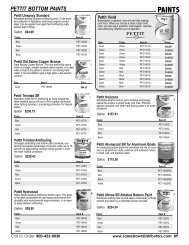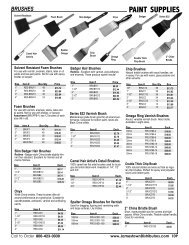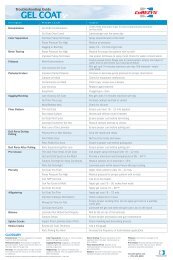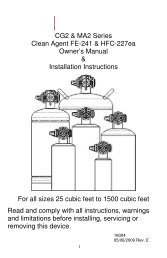technical manu al table of contents - Jamestown Distributors
technical manu al table of contents - Jamestown Distributors
technical manu al table of contents - Jamestown Distributors
You also want an ePaper? Increase the reach of your titles
YUMPU automatically turns print PDFs into web optimized ePapers that Google loves.
any better (or worse) than a specified system. As we have <strong>of</strong>ten said in the past;<br />
“whatever works”.<br />
Question:<br />
Is there any advantage to warming or heating varnish prior to its application or does it<br />
depend on how it is applied i.e. brushing, spraying, rolling etc. Also, if using a brush, how<br />
much varnish should be put on it before applying it to the surface.?<br />
Answer:<br />
We have about the same number <strong>of</strong> c<strong>al</strong>ls from finishers that chill their varnish prior to<br />
use and those that warm the varnish prior to use. Both claim that the varnish works<br />
better. Go figure. When varnish is heated, it thins out. Gener<strong>al</strong>ly, a warmer, thinner<br />
varnish will flow out better, particularly in a colder temperature. However, keep in mind<br />
that the solvent evaporates as the varnish is heated, therefore it may accelerate the<br />
drying time to the point <strong>of</strong> working against you. There is a danger in applying too thick a<br />
coat. This could result in wrinkling. This is less likely in a spray application where the<br />
coats are norm<strong>al</strong>ly thinner. Solvent is added so that you can brush it comfortably. Take<br />
that away and it may be harder to brush. On the other hand, cooling the varnish may<br />
stiffen it to the point <strong>of</strong> not flowing out well enough but it may give you an edge in hotter<br />
climates. We are firm believers in “whatever works”.<br />
Everyone has heard how varnish should be “laid on” and not brushed. There is much<br />
truth to this. The more that you wave a brush full <strong>of</strong> varnish around, the more solvent is<br />
evaporated and the stiffer the product will become. Varnish is most successful if applied<br />
then ignored. Just let the varnish do its thing. As for quantity, on horizont<strong>al</strong> surfaces,<br />
don’t be shy. You can be quite generous without applying too much. Keep the brush wet<br />
and reload when it starts to drag. On vertic<strong>al</strong> surfaces there is a fine line between just<br />
right and too much. Practice until you get it right.<br />
One last point to ponder. Each <strong>manu</strong>facturer creates a formulation that is just right for<br />
whatever they are trying to achieve. Varnishing is 95% technique. Changing the<br />
formulation beyond the <strong>manu</strong>facturers specs. will only weaken the finish ultimately.<br />
Spend more time on technique and less on additives, heating or chilling.<br />
Question:<br />
Could you explain under what conditions a varnish accelerator additive should be used<br />
and, <strong>al</strong>ternately, when a retarder additive is appropriate?<br />
Answer:<br />
Firstly, care should be taken when adding any kind <strong>of</strong> solvent or additive to any product.<br />
Varnishes are made to strict formulations, and for a reason. Doctoring up a product to<br />
suit ones self-may in fact be “weakening” or producing a lesser qu<strong>al</strong>ity finish. Stick to the<br />
guidelines and use products that are <strong>manu</strong>factured specific<strong>al</strong>ly for that product.
















